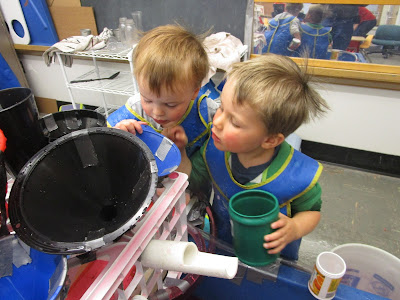Last week I told you my story about the
hand pump. This week I would like to tell you a story about the children and the hand pump.
The story begins with three girls cooperating to make the pump work. Their actions are full-body actions that take a lot of effort and a lot of coordination. The handle is not long enough to accommodate three pairs of hands so their hands are on top of each other as they work in unison. The child on the right wants to give more power to her pumping action so she starts to jump. Almost immediately, the child on the left also begins to jump.
Working the pump from
Thomas Bedard on
Vimeo.
Their jumping action takes on a teeter-totter rhythm which interferes with their coordinated action. As a consequence, their pumping ceases.
After these children leave, another child tries his hand at the pump. He figures out how to do it himself. By jumping, he is able to put the force of his whole weight behind his pumping stroke. He does not have to coordinate his jumping with anyone else, but he does have to coordinate his jump with the downward thrust of his arms. You can see a couple of times in the video that his timing is a little off and his pumping is interrupted.
Jump pumping from
Thomas Bedard on
Vimeo.
This video also captures a conversation between two children that is important to the story. We don't hear it, but the child on the boy's right has already asked if she could try the pump. A child off camera says: "And if she is not strong enough, you can do it together." To which the boy responds: "No, she's going to try by herself." As the video backs away to include all of the sensory table, we can see with whom the boy is talking. It is one of the girls from the first video who knows how hard it is to pump and thinks that the child waiting patiently to pump may need help. In fact she states: "But if it can't move that means there needs to be help."
One of the things to note about this conversation is how it arises naturally in the course of the children's work. It also incorporates their point of view---from their own experiences---relating to how they think the waiting child will make the pump work.
One other note about this video is how patient the child is who is waiting for a turn. Is that because she knows she will get a turn because of an implied message from the boy who says she's going to try to pump by herself?
Her patience pays off and she does indeed get a turn. And she does indeed try it by herself.
As you can see, she is working hard to make the hand pump work. She is even using her left foot to create more leverage. No matter how hard she tries, though, she cannot get it to work.
Help enters the picture in the form of the child who already knows from experience gained in the first video that it sometimes takes more than one person to make the pump go. Even with two people it is not so easy. First they try to jump together to push the handle up, but since they do not do it in sync, that does not work. They pause ever so briefly and reposition themselves under the handle and push up together. When the handle is lifted as high as it can go, they shift their weight together to pull down on the handle. At this point, they realize they have reached synchronicity. The one child exclaims: We're doing it!
We're doing it! from
Thomas Bedard on
Vimeo.
As I began to write this post, I thought I knew what this story was about. I thought it was about children figuring out how to use the pump. I also appreciated that there was a strand with a beginning, middle and end running through the story. The strand is embodied in the child helping another child work the pump by using her knowledge gained from previous experience.
That story is still there, but there is much more. There is a part of the story for which language is inadequate in the telling. That part has to do with questions that arise around how the children communicate and coordinate their actions. When they tried to communicate verbally by saying jump, they did not coordinate their actions. How, then, did they figure out how to coordinate their actions? And at what point did they know they were in sync and that they were making the pump work? If you watch the video carefully, you will see that the communication and the knowing is in the physical realm. How do you explain that their bodies figure it out and that their bodies know?
By the way, the pump was not designed to be so difficult to work. I did not lubricate the pump until days after introducing pump. It actually got harder and harder to pump until I realized I needed to add a little oil. Without this serendipitous mistake, I probably would have had a much different story to tell and query to add.
 A hole already existed in the bottom of the top box. I cut a flap in the bottom box to create a slit for the corn to drop into from the top box.
A hole already existed in the bottom of the top box. I cut a flap in the bottom box to create a slit for the corn to drop into from the top box.

























